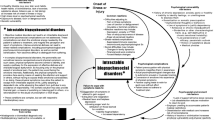Abstract
The construct of “pain behaviors” as observable and measurable manifestations of pain occupies a central role in Fordyce's operant model of pain. The present study was designed to evaluate the multidimensional nature of the construct and to explore the psychometric properties of a newly developed self-report instrument called the Pain Behavior Check List (PBCL). Subjects were 126 chronic pain patients who completed an initial version of the PBCL and other standardized questionnaires as part of their evaluation by the West Haven VAMC. Factor analysis identified four factors labeled Distorted Ambulation, Affective Distress, Facial/Audible Expressions, and Seeking Help. Substantial reliability and stability estimates for the total PBCL and the subscales support the potential clinical and theoretical utility of the instrument.
Similar content being viewed by others
References
Beck, A. T., Ward, C. H., Mendelson, M., Mock, J., and Erbaugh, J. (1961). An inventory for measuring depression.Arch. Gen. Psychiat. 4: 561–571.
Cronbach, L. J. (1951). Coefficient alpha and the internal structure of tests.Psychometrika 16: 297–334.
Feuerstein, M., Greenwald, M., Gamache, M. P., Papciak, A. S., and Cook, E. W. (1985). The pain behavior scale: Modification and validation for outpatient use.J. Psychopathology Behav. Assess. 7: 301–315.
Follick, M. J., Ahern, D. K., Laser-Wolston, N., Adams, A. E., and Molloy, A. J. (1982). An electromechanical recording device for the measurement of “uptime” and “downtime” in chronic pain patients.Arch. Phys. Med. Rehabil. 66: 75–79.
Follick, M. J., Ahern, D. K., and Laser-Wolston, N. (1984). Evaluation of a daily activity diary for chronic pain patients.Pain 19: 373–382.
Fordyce, W. E. (1976).Behavioral Methods for Chronic Pain and Illness, Mosby, St. Louis, MO.
Fordyce, W. E. (1979). Behavioral concepts in chronic pain and illness. In Davidson, P. O. (ed.),The Behavioral Management of Anxiety, Depression and Pain, Brunner/Mazel, New York, pp. 147–188.
Fordyce, W. E., Lansky, D., Calsyn, D. A., Shelton, J. L., Stolor, W. C., and Rock, D. L. (1984). Pain measurement and pain behavior.Pain 18: 53–69.
Keefe, F. J., and Block, A. R. (1982). Development of an observation method for assessing pain behavior in chronic low back pain patients.Behav. Ther. 13: 363–375.
Kerns, R. D., Turk, D. C., and Rudy, T. E. (1985). The West Haven-Yale Multidimensional Pain Inventory (WHYMPI).Pain 23: 345–356.
Loeser, J. (1980). Low back pain. In Bonica, J. J. (ed.),Pain, Raven Press, New York.
Melzack, R. (1975). The McGill Pain Questionnaire: Major properties and scoring methods.Pain 1: 277–299.
Richards, J. S., Nepomuceno, C., Riles, M., and Suer, Z. (1982). Assessing pain behavior: The UAB Pain Behavior Scale.Pain 14: 393–398.
Sanders, S. H. (1980). Toward a practical instrument system for the automatic measurement of “uptime” in chronic pain patients.Pain 15: 103–109.
Speilberger, C. D., Gursuch, R. I., and Luschene, R. F. (1970).STAI Manual for the State-Trait Anxiety Inventory, Consulting Psychologists Press, Palo Alto, CA.
Teshe, K., Daut, R. L., and Cleeland, C. S. (1983). Relationship between nurses' observations and patients' self-report of pain.Pain 31: 277–295.
Turk, D. C., and Flor, H. (1987). Pain > pain behaviors: The utility and limitations of the pain behavior construct.Pain 31: 277–295.
Turk, D. C., Wack, J. T., and Kerns, R. D. (1985). An empirical examination of the “pain behavior” construct.J. Behav. Med. 8: 119–130.
Turner, J. A., and Clancy, S. (1988). Comparison of operant-behavioral and cognitive-behavioral group treatment for chronic low back pain.J. Consult. Clin. Psychol. 56: 261–266.
Author information
Authors and Affiliations
Additional information
This research was supported by Department of Veterans Affairs Merit Review funds awarded to the first author.
Rights and permissions
About this article
Cite this article
Kerns, R.D., Haythornthwaite, J., Rosenberg, R. et al. The pain behavior check list (PBCL): Factor structure and psychometric properties. J Behav Med 14, 155–167 (1991). https://doi.org/10.1007/BF00846177
Accepted:
Issue Date:
DOI: https://doi.org/10.1007/BF00846177




